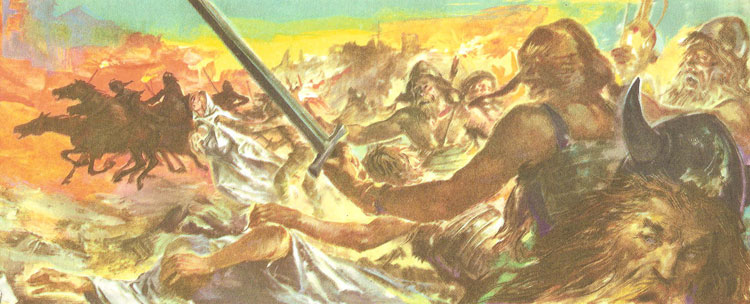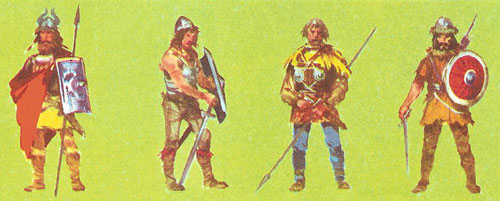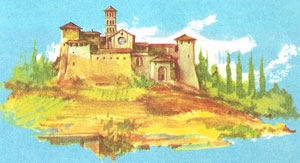downfall of the Roman Empire

A typical scene in the sack of Rome by Alaric.

Costumes of the barbarians who invaded Italy in the 6th, 7th, and 8th centuries AD.
At the height of its power the Roman Empire extended from Britain in the north to Egypt in the south – from Spain in the west to Persia in the east. Everywhere Roman armies had been triumphant, and to millions of savage and ignorant people Rome had brought civilization and peace. Yet, with all its glories, the Roman Empire was not destined to last. It was overrun by barbarian tribes from the east, and ended in confusion and misery.
What were the reasons for this? Why did this mighty empire collapse? Obviously there are numerous reasons, but the fundamental one was that the Romans were not the type of people they had once been: by the end of the fourth century they were no longer the adventurous, freedom-loving people of Rome at its prime. The great wealth of the Empire had brought with it much luxury and idleness, and this had had a rotting effect on the Roman character. They had become soft; they began not to care, to let things slide and to shirk their responsibilities. Dangerous and difficult jobs, particularly in the army, were left to foreigners. There was a decline in Roman literature and art. Above all, the Romans lost their political freedom, and tamely submitted to an emperor who was usually chosen by the army.
The beginning of the end
The story of the collapse of Rome is a very tragic one, and also a very long one; it did not occur suddenly, but extended over about a hundred years. In tracing the main events it is difficult to know where to start, but perhaps it was in the year AD 330 that the downfall of Rome became inevitable. For it was in this year that Constantinople became capital of the Empire instead of Rome. This meant that the center of gravity of the Empire shifted eastwards and more attention was given to the defense of Rome's eastern frontier than to the western frontier. Here a number of German races had settled. It will be remembered that, although Rome conquered most of Europe, she never conquered Germany. Perhaps this country with its vast forests and rigorous climate had few attractions. Certainly the German tribes (Goths, Vandals, Franks, Burgundians, and others) were extremely fierce and warlike. Large, violent men with long fair hair and light-blue eyes, they were utterly devoted to war and had been a constant menace to the Roman frontiers. However, after a great deal of fighting they had been driven back across the Danube and in time had become more friendly with Rome; many of them had joined the Roman army.
Disaster
However, in 375 a new menace appeared; the lands of the Germans were invaded from the east by a savage Mongolian people called the Huns. They were great warriors and swept all before them. In their despair the Goths asked the Romans if they could cross the Danube and settle in the Empire.
At first a certain number were allowed in, but then as more appeared, fleeing in terror from the fearful Huns, the Romans tried to stop them. However, it was too late. Already thousands of Goths had poured in, and three years later, in 378, they gained a decisive victory over the Romans near Adrianople. After this they settled in Dalmatia (present-day Croatia), and for a time there was peace.
However, in 395 the great Roman emperor, Theodosius, died, and the Empire was then divided in half (Eastern and Western) between his two sons, both of whom were very feeble. Immediately the Goths were on the move again. At first, under their leader, Alaric, they went south and attacked Greece, but later, in the year 400, they marched on Rome itself. Here at first they were checked, and in 402 they were defeated by a Roman army under the Vandal commander, Stilicho. A few years later, however, this general was put to death by a selfish and ungrateful emperor, and once again Alaric moved on Rome. For a time he was bought off with gold, but in 410 the final tragedy came. Rome was entered, there was a hideous massacre and the greatest city in the world was given over to plunder.
Fresh invasions
Already before this, other German races, under pressure from the Huns, were streaming westwards. In 406 the Vandals, looting and destroying as they went, passed through Gaul, on into Spain and thence into North Africa (on which Rome depended for her corn supply). Belgium was occupied by the Franks, and Gaul was invaded by the Goths and Burgundians. Britain had to be abandoned and then came under great pressure from Picts and Scots in the north and the Angles and Saxons in the south. In face of all this the Roman emperor of the West, who had now transferred his capital from Rome to Ravenna, was quite helpless. He was forced to give up most of his empire and submit to the rest being ravaged and looted. However, although he became little more than a figurehead, he was allowed for the time being to continue as emperor. The barbarians at heart had a kind of superstitious reverence for the Roman Empire, and were unwilling to destroy it entirely.
However, it was clear that the Roman Empire in the West could not last long: it was too easy a prey for the warlike barbarians who surround it. Thus in 435 the Vandals attacked it by sea from North Africa. Then in 451 it was attacked by the Huns under Attila (Known as 'The Scourge of God'). Fearful stories were told of this brutal savage who then dominated nearly all Europe. He was supposed never to show mercy, but for some reason he spared Rome. He is believed to have been persuaded by the Pope, Leo the Great, who told him how Alaric had died soon after he had sacked Rome. Soon afterwards the Huns left Italy and in Gaul they were heavily defeated by an army of Goths and Romans near Chalons. Two years later Attila died suddenly on his wedding night, and the power of the Huns came to an end.
The end
For 25 years more the Roman Empire in the West managed to survive, but in 476 it finally came to an end when the last emperor was turned dethroned by a barbarian chieftain. The Roman Empire in the East (or Byzantine Empire as it is sometimes called) was destined to last much longer – until the capture of Constantinople by the Turks in 1453. At one time (533) a famous Byzantine emperor, Justinian, succeeded in reconquering Italy which at that time was in the power of the Ostro-goths. However, his success was only temporary, and soon yet another tribe of barbarians, the Lombards, invaded Italy. At the same time the Franks were slowly bringing Gaul under their sway.
And so in the Dark Ages set in. In the history of the world there have been few greater tragedies: the highly civilized society of the Roman Empire was plunged into semi-barbarism. Where prosperous cities had stood were smoldering ruins. Cultivated fields reverted to moorland and forest. For the artisan, the teacher and the artist there was no work. For the merchant there were no customers. For the peasants toiling on the land there was the certainty that most of their harvest would either be taken from them or else destroyed. Roads became unusable. Always there was the threat of the passage of some army who would rob, burn, and sack everything. It was a time of appalling poverty from which Europe took centuries to recover.
The monasteries
 |
In these centuries of terror and poverty that followed the fall of the Roman Empire only in the monasteries was some peace and security to be found. They were founded all over Europe in the teeth of the invasions. The monasteries had libraries and schools and kept alive a knowledge of Roman literature and laws which they were able to hand on to the middle ages. A monastery typical of those in Italy, many of which were left untouched by the barbarians and some of which have survived to the present day.
Milestones in the downfall of Rome
330 Constantinople becomes capital of Empire instead of Rome
378 Romans defeated by Goths near Adrianople
395 Empire divided into two parts
410 Sack of Rome by Goths 451 Rome attacked by the Huns
476 Last Roman emperor deposed
